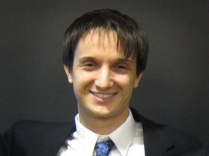Christopher E. Wilmer
University of Pittsburgh
Assistant Professor, Department of Chemical and Petroleum Engineering
Wednesday, February 13, 2019
Topic: Understanding Thermal Transport in Porous Crystals
Highly porous materials are very useful for chemical separations, catalysis, and gas storage. The last twenty years has been particularly exciting in this area because of the discovery of highly porous crystals called metal-organic frameworks (MOFs). By changing the building blocks used in their self-assembly, their pore structures can be tuned to target specific applications, and in two decades over 70,000 different MOFs have been reported in the literature.
However, an important property for the practical implementation of MOFs as industrial adsorbents has received relatively little attention over that time: thermal transport. Whenever gases are rapidly loaded and unloaded in porous materials, there is a sharp increase and decrease of temperature. In just the last few years, our understanding of thermal transport in porous crystals, and MOFs in particular, has increased significantly. Through molecular simulations, we have investigated the thermal conductivity of MOFs both as a function of their pore structure and also as function of gas loading [1-2]. An important observation of ours, which is contested and for which experimental support is scarce, is that thermal conductivity of MOFs generally decreases in the presence of adsorbed gases [3]. This observation, if found to be hold as a general phenomenon, implies greater challenges for MOFs as gas adsorbents: not only are they typically insulating materials to begin with, but their insulating nature is exacerbated by the presence of gases. In this talk we present our collected evidence on this important phenomenon and outline potential strategies to control and mitigate unwanted thermal effects in gas adsorption scenarios.
[1] K. B. Sezginel, P. A. Asinger, H. Babaei, and C. E. Wilmer, Thermal transport in interpenetrated metal-organic frameworks, Chemistry of Materials, 30, 2281-2286 (2018).
[2] H. Babaei, A. J. H. McGaughey, and C. E. Wilmer, Effect of pore size and shape on the thermal conductivity of metal-organic frameworks, Chemical Science, 8, 583-589 (2017).
[3] H. Babaei and C. E. Wilmer. Mechanisms of heat transfer in porous crystals containing adsorbed gases: Applications to metal-organic frameworks, Physical Review Letters, 116, 025902 (2016).
Biography
Chris was born in Canada to Polish parents who immigrated to Canada shortly before Poland went under martial law in 1981. Spurred by nanotechnology-driven visions of the future penned by writers Erik Drexler and Ray Kurzweil, Chris acquired a B.A.Sc. degree from the University of Toronto’s Engineering Science—Nanoengineering program. Coming to the United States to pursue a Ph.D. in Chemical Engineering at Northwestern under the mentorship of Prof. Randall Q. Snurr, he took an interest in the American way of developing new technologies—through entrepreneurship. While still a student, he co-founded, NuMat Technologies, which develops commercial gas storage solutions using MOFs, for which he was named to the Forbes Top 30-Under-30 list in Energy Innovation. At the University of Pittsburgh, he directs the Hypothetical Materials Lab, whose research focuses on advanced uses of porous crystals, such as in developing artificial noses or storing oxygen. His lab recently spun-out Aeronics, which manufactures inexpensive oxygen storage containers for people with decreased lung function. In his ample spare time (that is a joke) he is the managing editor of Ledger, the world's first scholarly journal focused on blockchain research, the technology that powers Bitcoin (that is not a joke).
Wednesday, February 13, 2019
- Time: 11.00 AM
- Location: 206 Furnas Hall
- Seminar Flyer

Christopher Wilmer
Assistant Professor,
University of Pittsburgh